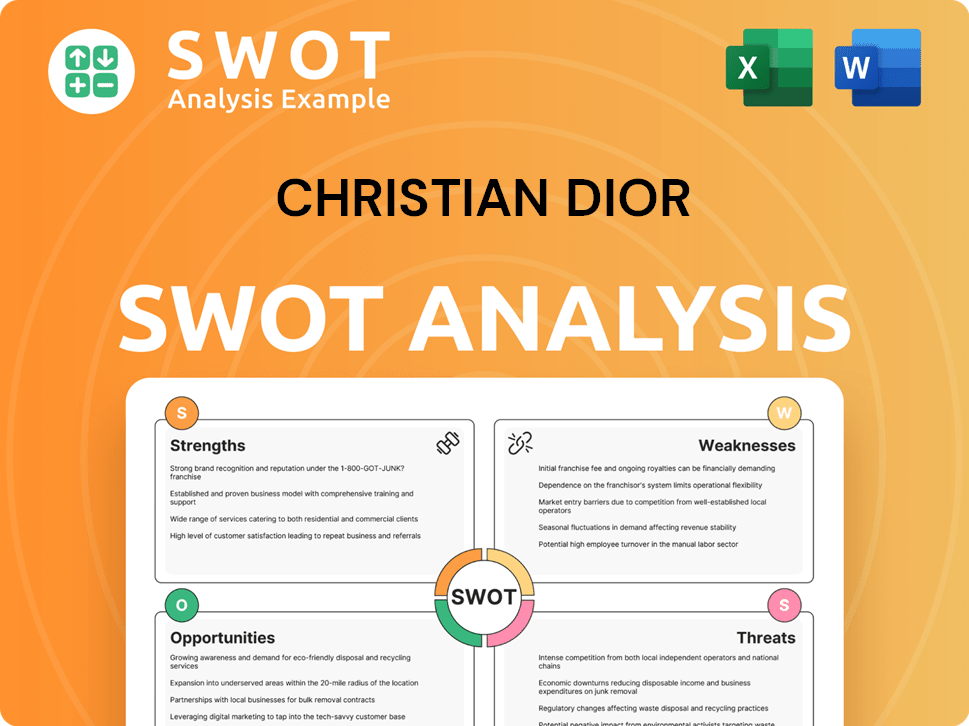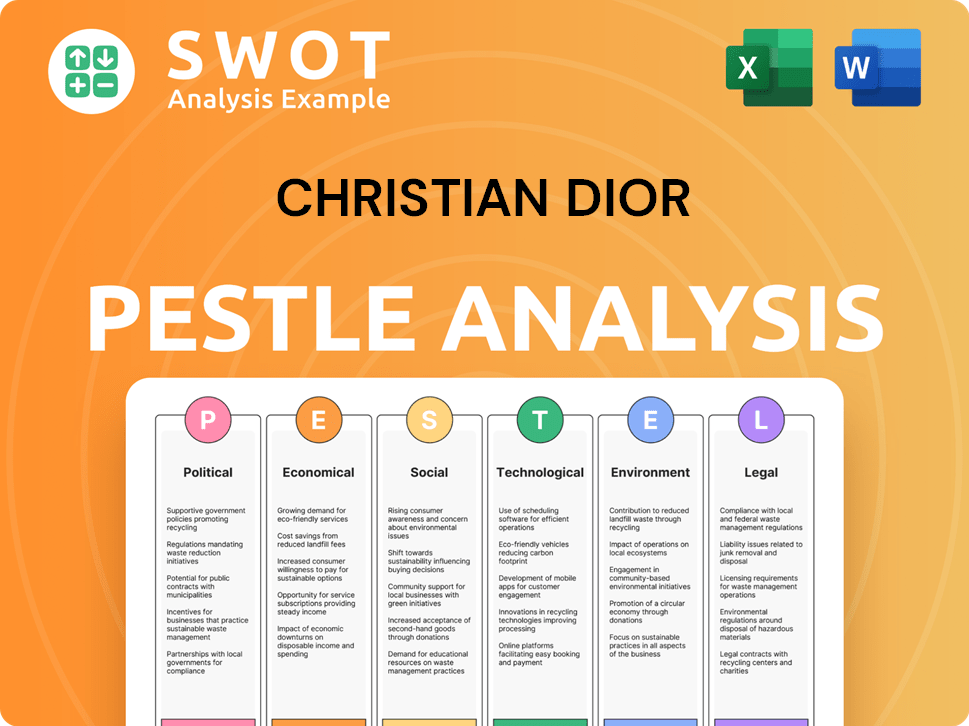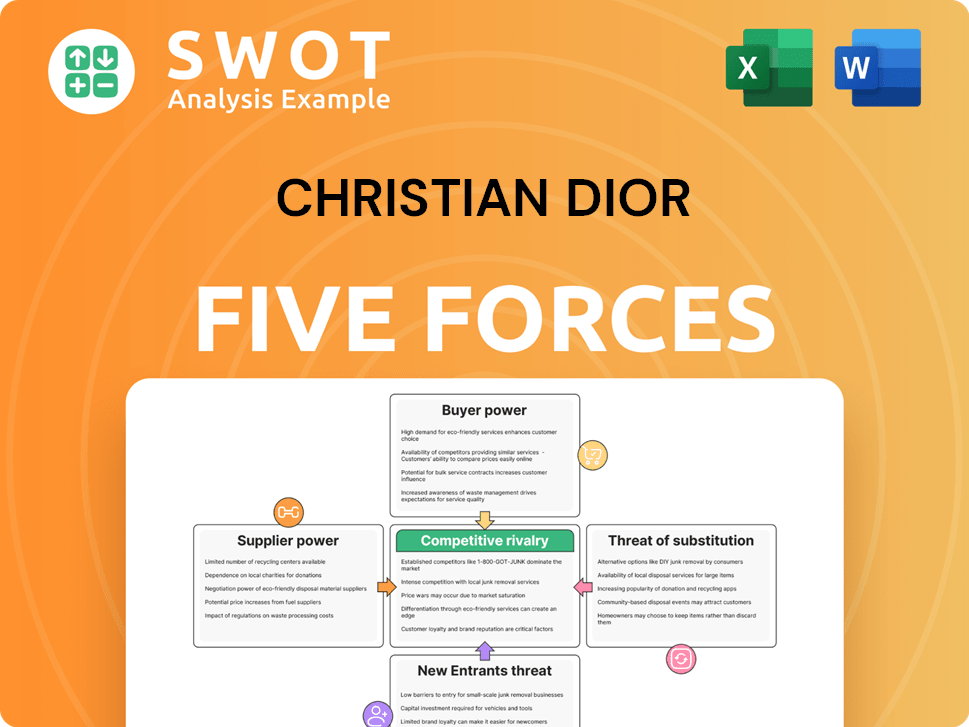Christian Dior Bundle
How Does Christian Dior Dominate the Luxury Arena?
Born from the ashes of post-war Paris, Christian Dior redefined elegance, launching a fashion revolution that continues to captivate the world. From its iconic 'New Look' to its expansive empire of luxury goods, Dior's legacy is one of enduring influence and unparalleled sophistication. Today, Dior stands as a titan in the Christian Dior SWOT Analysis, but how does it navigate the cutthroat world of luxury fashion brands?

This report dives deep into the Christian Dior competitive landscape, meticulously analyzing its key rivals and Dior's market analysis to understand its strategic positioning in the high-end retail sector. We'll dissect Dior's competitive advantages, examining its financial performance against its competitors and exploring the impact of industry trends. Uncover the secrets behind Dior's sustained success in the fashion industry competition and gain insights into its future trajectory.
Where Does Christian Dior’ Stand in the Current Market?
Christian Dior SE, through its primary asset Christian Dior Couture, holds a strong market position in the global luxury industry. While specific market share data for Christian Dior Couture isn't disclosed independently, its contribution to LVMH, the world's largest luxury group, is substantial. LVMH had a market capitalization of approximately €425 billion as of early 2024, with Dior playing a key role in revenue and brand prestige, especially in high-end fashion and leather goods.
Dior's product lines, which include haute couture, ready-to-wear, leather goods, and fragrances, cater to a wealthy global clientele. The brand maintains a strong presence in major luxury markets like Europe, Asia, and North America. Dior has also expanded its digital presence, adapting to consumer behavior and strengthening its e-commerce capabilities, which complements its physical boutiques, allowing it to reach a wider audience while maintaining its exclusive image. For a deeper dive into the brand's origins, you can read about the Brief History of Christian Dior.
Dior consistently positions itself at the premium end of the luxury market, avoiding mass-market segments. Its financial health, as reflected in LVMH's performance, is significantly stronger than many industry averages. LVMH's net profit reached €15.2 billion in 2023, demonstrating the financial strength supporting brands like Dior. Dior is particularly strong in established luxury markets and continues to invest in emerging markets, particularly in Asia, to capitalize on increasing affluence and demand for high-end goods.
Dior's core operations focus on designing, manufacturing, and distributing luxury goods. This includes haute couture, ready-to-wear fashion, leather goods, accessories, footwear, and a wide range of beauty products. The brand operates through a network of boutiques, department stores, and online channels, ensuring global reach and brand control.
Dior offers a value proposition centered on luxury, exclusivity, and craftsmanship. The brand is known for its high-quality materials, innovative designs, and iconic status. Dior's products represent a lifestyle of elegance and sophistication, attracting a discerning customer base seeking premium products and brand prestige.
Dior's strong market position is supported by its brand recognition, product quality, and global presence. The brand competes in the luxury fashion and beauty segments, facing rivals like Chanel, Gucci, and Prada. Dior's ability to maintain its premium pricing and expand its market share is crucial to its success. The competitive landscape of Christian Dior is influenced by factors such as brand image, distribution, and marketing strategies.
- Brand Recognition: Dior benefits from high brand awareness and a strong reputation for quality.
- Product Range: A diverse product portfolio across fashion, leather goods, and beauty products.
- Distribution Network: Extensive network of boutiques and online presence.
- Financial Performance: Consistent revenue growth and profitability, supported by LVMH's resources.
Christian Dior SWOT Analysis
- Complete SWOT Breakdown
- Fully Customizable
- Editable in Excel & Word
- Professional Formatting
- Investor-Ready Format

Who Are the Main Competitors Challenging Christian Dior?
The Christian Dior competitive landscape is characterized by intense rivalry within the luxury goods sector. This competition spans various segments, including haute couture, ready-to-wear, leather goods, fragrances, and cosmetics. Understanding these competitive dynamics is crucial for assessing Dior's market position and strategic initiatives.
Dior's success hinges on its ability to differentiate itself through design, brand image, and customer experience. The luxury market's high barriers to entry and the significance of brand heritage further shape the competitive environment. The company consistently adapts its strategies to maintain its position against both direct and indirect competitors.
Dior faces significant competition from direct rivals in the luxury fashion market. These competitors include established brands and emerging players that challenge Dior's market share and brand recognition. The competitive landscape is dynamic, with companies constantly innovating and adapting to consumer preferences and market trends.
Key direct competitors include Chanel, Hermès, Gucci (Kering Group), Louis Vuitton (LVMH), Prada, and Versace (Capri Holdings). These brands compete directly in haute couture, ready-to-wear, and leather goods. They often use high-profile runway shows and celebrity endorsements to attract market attention.
Chanel is a significant competitor, particularly in high fashion, fragrances, and accessories. As a privately held company, Chanel's financial performance is not fully disclosed, but it remains a dominant force in the luxury market. Chanel's brand image and heritage are key to its competitive advantage.
Hermès competes in the ultra-luxury segment, known for its exquisite leather goods. In 2023, Hermès reported a revenue increase of 17%, reaching €13.4 billion, demonstrating its strong competitive position. Hermès emphasizes craftsmanship and exclusivity, appealing to a discerning clientele.
In fragrances and cosmetics, Dior competes with brands like Chanel Beauty, Estée Lauder Companies (MAC, Clinique, La Mer), L'Oréal Luxe (Lancôme, Yves Saint Laurent Beauty), and Coty Inc. These competitors invest heavily in R&D, celebrity endorsements, and distribution networks.
L'Oréal's Luxe division is a major competitor, with sales reaching €14.9 billion in 2023. This highlights the intense competition in the beauty segment. L'Oréal's diverse brand portfolio and global presence pose a significant challenge to Dior.
Indirect competitors include high-end jewelry and watch brands like Cartier (Richemont Group), Tiffany & Co. (LVMH), and Rolex. These brands compete for the same discretionary spending from affluent consumers. Emerging luxury brands and DTC players also pose a threat.
The luxury market is shaped by mergers, acquisitions, and strategic alliances. LVMH's acquisition of Tiffany & Co. in 2021 for approximately $15.8 billion is a prime example of market consolidation. Dior must continuously innovate and differentiate its offerings to maintain its competitive edge.
- Brand Positioning: Dior's brand image and heritage are crucial for attracting and retaining customers.
- Innovation: Continuous innovation in design, materials, and marketing is essential.
- Distribution: Expanding and optimizing distribution channels, including online platforms, is key.
- Customer Experience: Providing exceptional customer service and personalized experiences.
- Sustainability: Addressing sustainability concerns and incorporating eco-friendly practices.
Christian Dior PESTLE Analysis
- Covers All 6 PESTLE Categories
- No Research Needed – Save Hours of Work
- Built by Experts, Trusted by Consultants
- Instant Download, Ready to Use
- 100% Editable, Fully Customizable

What Gives Christian Dior a Competitive Edge Over Its Rivals?
The competitive landscape for Christian Dior, a prominent player in the luxury fashion market, is shaped by its strong brand equity and strategic positioning. Since its founding in 1946, the brand has cultivated a reputation for elegance and innovation, which translates into customer loyalty and premium pricing. This enduring appeal is a key factor in understanding the Christian Dior competitive landscape.
Dior's integration within the LVMH Moët Hennessy Louis Vuitton conglomerate provides significant advantages. This affiliation offers access to vast resources, global distribution networks, and shared expertise, enhancing its market reach and operational efficiency. The luxury fashion industry competition is fierce, but Dior's backing from LVMH gives it a considerable edge.
The brand's commitment to exquisite craftsmanship and quality across its product categories, from haute couture to leather goods and fragrances, further differentiates it. The 'Made in France' or 'Made in Italy' provenance for many products appeals to discerning consumers. Dior's ability to attract top designers and artisans maintains its creative edge. To learn more about how Dior achieves its success, consider exploring the Growth Strategy of Christian Dior.
Dior's brand heritage, dating back to 1946, is a cornerstone of its competitive advantage. The brand's name is synonymous with luxury and elegance. This strong recognition allows Dior to maintain premium pricing and customer loyalty, which is crucial in the high-end retail sector.
Being part of LVMH provides Dior with significant resources and a global distribution network. This includes access to shared expertise in retail management, marketing, and supply chain logistics. LVMH's extensive global retail footprint, with over 5,600 stores worldwide as of 2023, boosts Dior's distribution capabilities.
Dior's commitment to superior craftsmanship is a key differentiator. The 'Made in France' or 'Made in Italy' label signifies high quality, attracting discerning consumers. Specific product features, such as the iconic Lady Dior bag, generate significant revenue and reinforce its distinct identity.
Dior attracts top designers, perfumers, and artisans, maintaining its creative edge. This talent pool ensures continuous innovation in product design and marketing strategies. The brand's ability to stay ahead of trends is crucial in the fashion industry competition.
Dior faces challenges from imitation, particularly counterfeit goods, and shifts in consumer preferences towards sustainability and digitally native brands. The Dior market analysis must consider these threats. The luxury fashion brands market is highly competitive, requiring continuous adaptation.
- Counterfeit goods pose a significant threat to brand integrity and revenue.
- Changing consumer preferences, including a focus on sustainability, require strategic adjustments.
- The rise of digitally native brands demands a strong online presence and innovative marketing.
- Maintaining brand exclusivity and premium pricing in a competitive market is an ongoing challenge.
Christian Dior Business Model Canvas
- Complete 9-Block Business Model Canvas
- Effortlessly Communicate Your Business Strategy
- Investor-Ready BMC Format
- 100% Editable and Customizable
- Clear and Structured Layout

What Industry Trends Are Reshaping Christian Dior’s Competitive Landscape?
The luxury fashion industry, including the competitive landscape of Christian Dior, is currently undergoing significant transformations driven by technological advancements, evolving consumer preferences, and increased scrutiny regarding sustainability. These shifts present both challenges and opportunities for Dior. Understanding these trends is crucial for assessing Dior's market position and future prospects. Revenue Streams & Business Model of Christian Dior offers additional insights into the brand's operations and strategies.
Dior's market analysis reveals that the brand faces pressures from intensified competition, economic uncertainties, and geopolitical instability. However, opportunities exist in expanding into emerging markets, product innovation, and strategic partnerships. Dior's ability to adapt to these dynamics will determine its success in the high-end retail sector and its position within the fashion industry competition.
Technological advancements, particularly in e-commerce and digital engagement, are reshaping how luxury brands interact with consumers. Regulatory changes regarding sustainability and ethical sourcing are also influencing the industry. Evolving consumer preferences, especially among younger demographics, drive demand for personalized experiences and authentic brand narratives.
Intensified competition from emerging luxury brands and economic downturns impacting discretionary spending pose significant challenges. Geopolitical instability affecting global supply chains and consumer confidence is another concern. The rise of 'quiet luxury' and a potential shift away from overt branding could also necessitate strategic adjustments.
Expanding into emerging markets, particularly in Southeast Asia and the Middle East, presents significant growth opportunities. Product innovations, especially in sustainable materials and personalized beauty solutions, offer avenues for growth. Strategic partnerships, such as collaborations with artists or other luxury brands, can generate new interest and expand market reach.
Dior needs to enhance its online presence and explore new technologies like NFTs and the metaverse for brand engagement. The brand is investing in initiatives to reduce its environmental footprint and enhance transparency. Targeted marketing campaigns and collaborations will be essential to engage with younger demographics.
Dior's competitive position is likely to evolve towards a more digitally integrated, sustainably conscious, and culturally resonant brand. The brand will deploy strategies focused on innovation, targeted market expansion, and maintaining its core values of exclusivity and craftsmanship. Dior's main rivals include Chanel, Gucci, and other major players in the luxury fashion brands market.
- Market Share Dynamics: In 2024, LVMH, Dior's parent company, reported a revenue increase, indicating strong performance within the luxury market.
- Financial Performance vs. Competitors: Dior's financial performance is closely tied to LVMH's overall results, which consistently show growth in the fashion and leather goods segment, reflecting Dior's contribution.
- Digital Presence and Competition: Dior has been actively enhancing its online presence, with e-commerce sales contributing significantly to overall revenue, reflecting a response to digital competition.
- Sustainability Initiatives: Dior is investing in sustainable practices, aligning with consumer demand for ethical and environmentally friendly products, a key factor in the fashion industry competition.
Christian Dior Porter's Five Forces Analysis
- Covers All 5 Competitive Forces in Detail
- Structured for Consultants, Students, and Founders
- 100% Editable in Microsoft Word & Excel
- Instant Digital Download – Use Immediately
- Compatible with Mac & PC – Fully Unlocked

Related Blogs
- What are Mission Vision & Core Values of Christian Dior Company?
- What is Growth Strategy and Future Prospects of Christian Dior Company?
- How Does Christian Dior Company Work?
- What is Sales and Marketing Strategy of Christian Dior Company?
- What is Brief History of Christian Dior Company?
- Who Owns Christian Dior Company?
- What is Customer Demographics and Target Market of Christian Dior Company?
Disclaimer
All information, articles, and product details provided on this website are for general informational and educational purposes only. We do not claim any ownership over, nor do we intend to infringe upon, any trademarks, copyrights, logos, brand names, or other intellectual property mentioned or depicted on this site. Such intellectual property remains the property of its respective owners, and any references here are made solely for identification or informational purposes, without implying any affiliation, endorsement, or partnership.
We make no representations or warranties, express or implied, regarding the accuracy, completeness, or suitability of any content or products presented. Nothing on this website should be construed as legal, tax, investment, financial, medical, or other professional advice. In addition, no part of this site—including articles or product references—constitutes a solicitation, recommendation, endorsement, advertisement, or offer to buy or sell any securities, franchises, or other financial instruments, particularly in jurisdictions where such activity would be unlawful.
All content is of a general nature and may not address the specific circumstances of any individual or entity. It is not a substitute for professional advice or services. Any actions you take based on the information provided here are strictly at your own risk. You accept full responsibility for any decisions or outcomes arising from your use of this website and agree to release us from any liability in connection with your use of, or reliance upon, the content or products found herein.